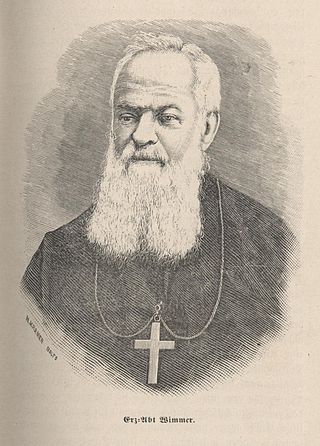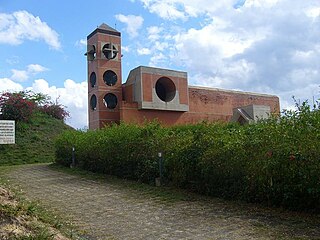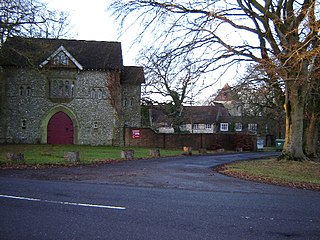
The Benedictines, officially the Order of Saint Benedict, are a mainly contemplative monastic religious order of the Catholic Church for men and for women who follow the Rule of Saint Benedict. The male religious are also sometimes called the Black Monks, in reference to the colour of their religious habits, in contrast to other Benedictine orders such as the Olivetans, who wear white. They were founded in 529 by Benedict of Nursia, a 6th-century Italian monk who laid the foundations of Benedictine monasticism through the formulation of his Rule. Benedict's sister, Scholastica, possibly his twin, also became a religious from an early age, but chose to live as a hermit. They retained a close relationship until her death.

The Trappists, officially known as the Order of Cistercians of the Strict Observance and originally named the Order of Reformed Cistercians of Our Lady of La Trappe, are a Catholic religious order of cloistered monastics that branched off from the Cistercians. They follow the Rule of Saint Benedict and have communities of both monks and nuns that are known as Trappists and Trappistines, respectively. They are named after La Trappe Abbey, the monastery from which the movement and religious order originated. The movement first began with the reforms that Abbot Armand Jean le Bouthillier de Rancé introduced in 1664, later leading to the creation of Trappist congregations, and eventually the formal constitution as a separate religious order in 1892.

A monk is a person who practices religious asceticism by living a monastic lifestyle, either alone or with any number of other monks. A monk may be a person who decides to dedicate his life to serving other people and serving God, or to be an ascetic who voluntarily chooses to leave mainstream society and live his life in prayer and contemplation. The concept is ancient and can be seen in many religions and in philosophy.
In Christianity, an oblate is a person who is specifically dedicated to God and to God's service.

Archabbot Boniface Wimmer, (1809–1887) was a German monk who in 1846 founded the first Benedictine monastery in the United States, Saint Vincent Archabbey in Latrobe, Pennsylvania, forty miles southeast of Pittsburgh.

Westminster Abbey is a community of Benedictine monks in Mission, British Columbia, established in 1939 from the Abbey of Mount Angel, Oregon. The abbey is home to the Seminary of Christ the King and is a member of the Swiss American Congregation within the Benedictine Confederation.

San José Abbey, Güigüe, Venezuela, is a Benedictine abbey of the Congregation of Missionary Benedictines of Saint Ottilien. Currently located to the south of Lago de Valencia, the monastic community was originally established as a mission procure in Caracas following World War I. Caracas' expansion restrained the development of the abbey, and in the late 1980s the monks relocated to Güigüe. The community's superior is Fr Abbot José María Martínez Barrera.

Saint Anselm Abbey, located in Goffstown, New Hampshire, United States, is a Benedictine abbey composed of men living under the Rule of Saint Benedict within the Catholic Church. The abbey was founded in 1889 under the patronage of Saint Anselm of Canterbury, a Benedictine monk of Bec and former archbishop of Canterbury in England. The monks are involved in the operation of Saint Anselm College. The abbey is a member of the American-Cassinese Congregation of the Benedictine Confederation.

Alton Abbey is an Anglican Benedictine monastery in the village of Beech, near Alton, Hampshire, England. The abbey is not far from one of Hampshire's highest points, King's Hill. The community was founded by the Revd Charles Plomer Hopkins in 1884, as the "Society of Saint Paul", in Rangoon (Burma) and Calcutta (India) to work with destitute or distressed merchant seafarers and their chaplains.
The Subiaco Cassinese Congregation is an international union of Benedictine houses within the Benedictine Confederation. It developed from the Subiaco Congregation, which was formed in 1867 through the initiative of Dom Pietro Casaretto, O.S.B., as a reform of the way of life of monasteries of the Cassinese Congregation, formed in 1408, toward a stricter contemplative observance, and received final approval in 1872 by Pope Pius IX. After discussions between the two congregations at the start of the 21st century, approval was given by Pope Benedict XVI in 2013 for the incorporation of the Cassinese Congregation into its offshoot, the Subiaco Congregation. The expanded congregation was given this new name.

The Bernardine Cistercians of Esquermes are a small branch of the Cistercian Order. They follow the Rule of St Benedict, and co-operate with the apostolic mission of the Catholic Church through educational activities and hospitality. There are eight monasteries of nuns in six countries, united by a central Government.
Prince of Peace Abbey, Tigoni, Nairobi Province, Kenya, is a Benedictine monastery of the Congregation of the Missionary Benedictines of Saint Ottilien. Established in 1978 at the request of Maurice Cardinal Otunga, the monastery is currently home to 50 monks. Abbot John Baptist Oese Imai is the community's superior.
Incarnation Conventual Priory, Agbang, Kara, Togo, is a Benedictine monastery of the Congregation of the Missionary Benedictines of Saint Ottilien. Established in 1985 by Frère Boniface Tiguila, the monastery is currently home to 28 monks. Conventual Prior Fr Bernard Anaté is the community's superior.
Christ the King Priory, Tororo, Eastern Region, Uganda, is a Benedictine monastery of the Congregation of Missionary Benedictines of Saint Ottilien. Established in the 1980s by Fr John Neudegger, OSB, the monastery is currently home to 24 monks. Fr Prior Fidelis is the community's superior.
St Michael's Priory, Kumily, Idukki, Kerala, India, is a Benedictine monastery of the Congregation of the Missionary Benedictines of Saint Ottilien. The monastery was established in 1987 by Zacharias Kuruppacheril, an Indian secular priest. Located on the western slopes of the Cardamom Hills, around 150 km east of Kochi, the monastery is currently home to 13 monks and 6 brothers in formation. Prior Fr.John Kaippallimyalil is the community's superior.
St Benedict's Conventual Priory, Digos, Davao del Sur, Philippines, is a Benedictine monastery of the Congregation of Missionary Benedictines of Saint Ottilien. Established in 1983 at the request of Bishop Generoso Camiña of the Diocese of Digos, the monastery is currently home to 21 monks. Conventual Priory Fr Edgar Friedmann is the community's superior.
The Abbey of St. Maurus is a Tanzanian Benedictine monastery of the Congregation of Missionary Benedictines of Saint Ottilien in Hanga, Ruvuma Region. Established in 1956 by Abbot-Bishop Eberhard Spiess as a formation house for African monastic candidates, the monastery is currently home to 122 monks. The abbey operates schools and a dispensary for the people of the local village and a seminary for the Roman Catholic Archdiocese of Songea.

Saint Maurus and Saint Placidus Abbey, Waegwan, Chilgok, North Gyeongsang, South Korea is a Benedictine monastery of the Congregation of Missionary Benedictines of Saint Ottilien. Established in 1952 by Korean monks who had survived the dissolution of the Territorial Abbey of Tokwon and Holy Cross Abbey in Yanji, the monastery is currently home to 131 monks. Fr Blasio Park is the current abbot.

Abbaye de Keur Moussa or simply Keur Mousa, near Dakar, the capital city of the Western African nation of Senegal, is a Benedictine monastery of the Solesmes Congregation. Founded in 1961 by French monks, the monastery became an abbey in 1984. As of 2000 the monastery was home to 26 monks under the leadership of Abbot Fr Philippe Champetier de Ribes Christofle. Recordings done by Sacred Spirit Music demonstrate the monks playing the kora harp and singing, and have reached Western audiences. Their music blends African rhythms and instruments with Western liturgical chant.

Andrew Hintenach, OSB was a German-born Catholic monk who served as the second archabbot of Saint Vincent Archabbey in Latrobe, Pennsylvania from 1888 to 1892.















